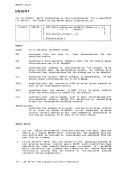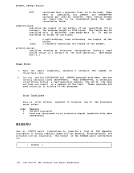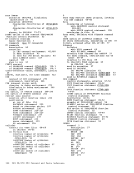DDR
2.
recorded on the tape produces a successful EOJ, but the printout
only indicates the last cylinder found on the tape.Use the PRINT and TYPE function statement to print or type (display) a
hexadecimal and EBCDIC translation of each record specified. The input
device must be defined as direct access. The output is directed to the
system console for theTYPE function, or to the SYSPRINT device for the PRIN'1" function. (This does not cause redefinition of the output unit
definition., The format of thePRINT/TYPE control statement is:
r----------------------------------------------------------------------,I PRint I cyll [hhl (rrl]] (To cy12 [hh2 [rr2 ]]] [(options ••• [)]] I I TYpe I I I I QE1ion§: , I , [Hex] [Graphic] [Count] I cVll is the starting cylinder.
hh 1
rr 1
is the starting track. If present,it must follow the cyll
operand. The default is track zero.
is the starting record. If present, it must follow the hhl
operand. The default is home address and record zero.TO cy12 is the ending cylinder. If more than one cylinder is to be
printed or typed,"TO cy12" must be specified.
hh2 is the ending
operand. The
cylinder.
track. If
default
present,it must
is the last track
follow the cy12
on the ending
rr2 is the record ID of the last record to print. The default is
the last record on the ending track.HEX prints or displays a hexadecimal representation of each
record specified.COUNT prints or displays an EBCDIC translation of each record
specified.
prints or displays only the count field for each record
specified.
If theTYPE statement follows the occurrence of error message DMKDDR705E
and specifies the same cylinder, track, and record extents indicated in
the error message, the contents of the printed record must be
interpreted in the context of theI/O error information given in the
in it ial message.
52IBM VM/37Q CMS Command and Macro Reference
2.
recorded on the tape produces a successful EOJ, but the printout
only indicates the last cylinder found on the tape.
hexadecimal and EBCDIC translation of each record specified. The input
device must be defined as direct access. The output is directed to the
system console for the
definition., The format of the
r----------------------------------------------------------------------,
hh 1
rr 1
is the starting track. If present,
operand. The default is track zero.
is the starting record. If present, it must follow the hhl
operand. The default is home address and record zero.
printed or typed,
hh2 is the ending
operand. The
cylinder.
track. If
default
present,
is the last track
follow the cy12
on the ending
rr2 is the record ID of the last record to print. The default is
the last record on the ending track.
record specified.
specified.
prints or displays only the count field for each record
specified.
If the
and specifies the same cylinder, track, and record extents indicated in
the error message, the contents of the printed record must be
interpreted in the context of the
in it ial message.
52






















































































































































































































































































































































































































